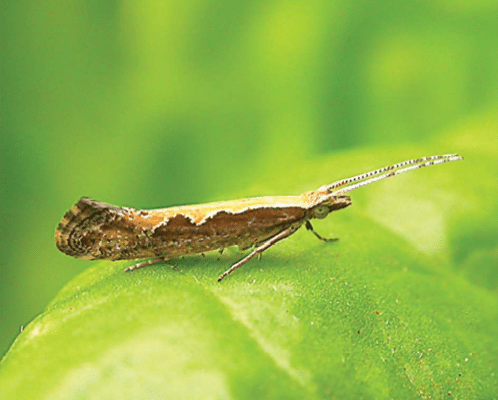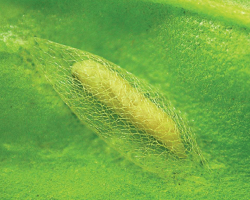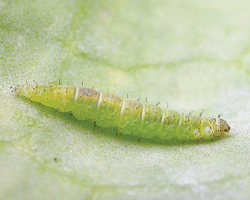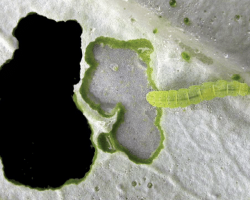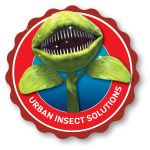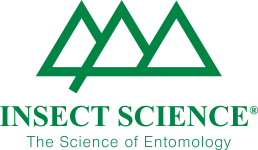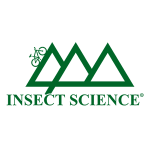Host plants
The larvae feed only on plants of the family Brassicaceae. Virtually all brassica vegetable crops are eaten, including broccoli, Brussel sprouts, cabbage, Chinese cabbage, cauliflower, collard, kale, kohlrabi, mustard, radish, turnip, and water cress. Several brassica weeds are important hosts, including wild mustard (Rspistrum rugosum and Sisymbruim spp.), wild radish (Raphanus raphanistrum), pepper cress (Lepidium spp.) and beesraap (Brassica rapa).
Damage
Only the larvae damage brassicas. Moths need not feed, although they are sometimes seen feeding at blossoms at night. First instar larvae that hatch are very small and their feeding usually goes unnoticed. From the second instar onwards, they feed on the underside of the leaves, stripping the lower leaf but leaving the upper epidermis intact, which results in window-like damage, as illustrated. The window-like areas soon become large irregular holes as the leaf grows and expands (illustrated). Larger larvae chew irregular holes right through the leaf.
Seedlings suffer severe damage as the young plants are either killed or head formations is disrupted. In severe infestations plants may be reduced to a lace like condition. When older, head forming cabbages are attacked, damage is less severe. Larvae are not known to tunnel into already formed heads.
Diamond-back moth is the most important insect pest of crops of the cabbage family throughout the world. It has become resistant to nearly all synthetic insecticides used against it in the field and to toxins from the bacterium Bacillus thuringiensis. In southern Africa, consumption of the cabbage crops as a staple vegetable, especially in rural and peri-urban areas, is steadily increasing and the pest status of the diamond-back moth is rising.
Life history
Mating takes place soon after emergence of the moths. They live for about 12-16 days, occasionally feeding on nectar and are active at night. Mating usually takes place at dusk. Eggs are laid on plants, usually in clusters of 2-8. Females that appear early in the season lay 250-300 eggs in their short lifetime, but egg production drops significantly as the season progresses, to an average of about 150 eggs per season. Eggs hatch after 4-8 days.
In southern Africa diamond-back moth larvae go through 5 instars, although reports from other countries only mention four. The larval stage is completed in 9-32 days, the average being 18 days. The larvae are extremely active; when disturbed, they wriggle rapidly to the end of the leaf and drop, suspended at the end of a long silken thread with which they later regain access to the leaf.
Pupation occurs on the underside of leaves or in debris on the ground, but in brassicas such as broccoli, pupae may be formed on florets. The fully grown larva spins a fine, loose silk cocoon in which it pupates. Adult moths appear 5-12 days (average nine days) after pupation.
The total development time from egg to egg is approximately 21-68 days, depending on ambient temperature. Although there are 4-15 generations a year, there are no apparent population peaks. Overlapping populations result in the presence of all stages of the pest at any particular time.
Natural enemies
More than 20 species of parasitic wasps associated with diamond-back moth have been recorded from southern Africa (Nofemela & Kfir, 2005). Common primary parasitoid Chelonus curvimaculants Cameron, the larval parasitoids Apanteles eriophyes Nixon and Coteisa vestalis (Haliday), better known as C. plutellae (Kurjamov) (all Braconidae), the larval-pupal parasitoids Diadegma mollipla (Holmgren) (Icheneumonidae) and Oomyzus sokolowskii (Kurdjumov) (Eulophidae) and the pupal parasitoid Tetrastichus howardi (Olliff) (Eulophidae). Common hyperparasitoids include Aphanogmus fijiensis (Ferrière) (Bethylidae), Brachymeria sp. (Chalcididae) and Pteromalus sp. (Pteromalidae).
Known predators include a rove beetle (Staphy-linidae) that devours pupae, brown (Hemerobiidae) and green (Chrysopidae) lacewings and hover fly larvae (Syrphidae) that feed on the larvae of the diamond-back moth. There is also an anthocorid bug that attacks the larvae of the moth.
Management
Natural mortality plays an important role in keeping diamond-back moth numbers low. Adverse weather conditions kill high numbers of both larvae and adults and rainfall is especially detrimental to the survival of larvae in open fields. However, natural mortality is usually not enough to limit economic damage and in most cases insecticide application is the only control option available. Unfortunately, diamond-back moth is notorious for developing resistance to most pesticides registered against it. Anti-resistance strategies are therefore vital, the most effective of which is the rotation of the insecticide classes and the use of microbial Bacillus thuringiensis products, which are crucial as they favour the survival of the natural enemies of the moth. Mixtures of the insecticides (so called cocktails), or chemicals and microbials, are often recommended for diamond-back moth control.
Because rainfall is known to be detrimental to larvae and moths, daily overhead irrigation has been shown to reduce their numbers in fields; the best results are obtained when irrigation is applied in the evenings, when moths are active.
Crop diversity can influence abundance of diamond-back moth. Larvae generally are fewer in number, and more heavily parasitized, when brassica crops are inter-planted with another crop or when weeds are present. This does not necessarily lead to reduction in damage, however. Surrounding cabbage crops with two or more rows of preferred brassica hosts, such as collard and mustard can delay or prevent the dispersal of diamond-back moth into cabbage crops.
Various parasitic wasps, as listed above, are known to attack all stages except the adult. Under certain conditions these parasitoids can have a marked influence on population densities. (Nofemela & Kfir, 2005) but when diamond-back moth numbers are very high, these parasitoids are not always effective (Capinera, 2001). Unfortunately, most of the insecticides registered against this pest are also detrimental to the parasitoids.

